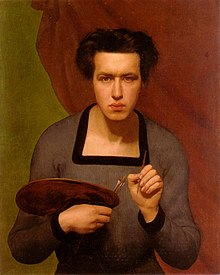Louis Janmot
Louis Janmot (born May 21, 1814 in Lyon , † June 1, 1892 ibid) was a French painter and poet.
Life
Youth and major works in Lyon
Janmot was born to deeply religious Catholic parents. He was deeply affected by the death of his brother (1823) and sister (1829). As a student at the Collège Royal de Lyon, he made the acquaintance of Frédéric Ozanam and other students of the philosophy teacher Abbé Noirot. In 1831 Janmot entered the École des Beaux-Arts de Lyon, where a year later he received the Laurier d'Or, the highest award. In 1836 he went to Paris to take painting lessons from André Jacques Victor Orsel and Jean-Auguste-Dominique Ingres . Together with other Lyons, Janmot joined the Vincent Community . In 1835 he followed to Rome together with Claudius Lavergne , Jean-Baptiste Frénet and other students , where he also met Hippolyte Flandrin .
After his return to Lyon in 1836, Janmot tried to attract the attention of critics in the Salon de Paris with large-format religious paintings such as La Résurrection du fils de la veuve de Naïm (1839) or Christ au Jardin des Oliviers (1840) . In 1845 he found attention with the painting Fleur des Champs from Charles Baudelaire , who dedicated a paragraph to him in the Salon de 1846 . The writer Théophile Gautier was taken with the Portrait de Lacordaire (1846). The failure of his Poème de l'âme on the occasion of the World's Fair in 1855 left Janmot disaffected. In December of the same year he married Léonie de Saint-Paulet, who came from a noble family from Carpentras .
1856 Janmot was commissioned a sacrament - Fresco (not received) to customize for the church Saint-Polycarpe. Further orders followed, for example for the painting of the church dome of Saint-François de Sales or for the town hall, which was just being renovated by his friend, the architect T. Desjardins. Janmot was appointed teacher at the École des Beaux-Arts.
Paris and Toulon
To everyone's surprise, Janmot settled in Paris in 1861 after being promised an assignment for St-Augustin , which was withdrawn three years later. Plagued by family and financial problems, Janmot took a teaching position at the École des Dominicains d'Arcueil . In addition, he made numerous portraits of his family as frescoes in his country estate in Bagneux (only photos survived).
After the birth of the seventh child in August 1870, Janmot's wife died in Bagneux. Before the approaching Prussian troops besieging his house, he fled to his father-in-law in Algiers , where he painted landscapes. He returned to Paris in June of the following year, where he led a lonely life. He found his house in Bagneux robbed. In 1878 Janmot completed a mural in the chapel of the Franciscains en Terre Sainte , but this work did not result in further commissions.
Faced with increasing family and financial problems, Janmot moved to Toulon , where, despite some commissions, he - another version of the Portrait de Lacordaire (1878, Musée de Versailles), Rosaire ( Saint-Germain-en-Laye , 1880), Martyre de sainte Christine ( Solliès-Pont , 1882) - led a modest existence. He completed the second part of the Poème de l'âme, since the former industrialist and patron Félix Thiollier had agreed to publish it.
In 1885 Janmot married a former student, Antoinette Currat, and settled in Lyon. There he made charcoal drawings on the subject of the afterlife , which can be regarded as a kind of continuation of the Poème de l'âme , including Le Purgatoire (1885) and La Fin des Temps (1888). In 1887, in Lyon and Paris, the over five hundred page volume Opinion d'un artiste sur l'art was published, containing Janmot's earlier published articles. Janmot died five years later at the age of 78.
"Poème de l'âme"
The 34-painting Poème de l'âme is Janmot's best-known work. For these works he wrote a cycle of poems , the first part of which was published in 1854 by the Vingtrinier publishing house in Lyon. In the 1881 publication in Saint-Étienne, Janmot added a second part to the poems, correcting some words in the first part, replacing individual stanzas and adding new ones.
Janmot made the following paintings:
First part Second part 1. Génération divine 19th Solitude 2. Le Passage des âmes 20th L'Infini 3. L'Ange et la mère 21st Rêve de feu 4th Le Printemps 22nd Amour 5. Souvenir du ciel 23. Adieu 6th Le Toit paternel 24. Le Doute 7th Le Mauvaus Sentier 25th L'Esprit you mal 8th. Cauchemar 26th L'Orgy 9. Le Grain de Blé 27. Sans Dieu 10. Première Communion 28. Le Fantôme 11. Virginitas 29 Chute fatale 12. L'Échelle d'or 30th Le Supplice de Mezence 13. Rayons de soleil 31. Les Générations du Mal 14th Sur la Montagne 32. Intercession maternelle 15th Un Soir 33. La Délivrance, ou vision de l'avenir 16. Le vol de l'âme 34. Sursum Corda 17th L'Idéal 18th Reality
Fonts
- Louis Janmot: Opinion d'un artiste sur l'art. Vitte & Perrussel, Lyon 1887.
literature
- Wolfgang Drost, Élisabeth Hardouin-Fugier: Louis Janmot, précurseur du symbolisme. C. Winter, Heidelberg 1994, ISBN 3-8253-0209-1 .
- Elisabeth Hardouin-Fugier: Louis Janmot, 1814-1892. Presses universitaires de Lyon, Lyon 1981, ISBN 2-7297-0106-0 .
Web links
- Janmot, (Anne-François-) Louis at artnet (English)
| personal data | |
|---|---|
| SURNAME | Janmot, Louis |
| BRIEF DESCRIPTION | French painter and poet |
| DATE OF BIRTH | May 21, 1814 |
| PLACE OF BIRTH | Lyon |
| DATE OF DEATH | June 1, 1892 |
| Place of death | Lyon |






